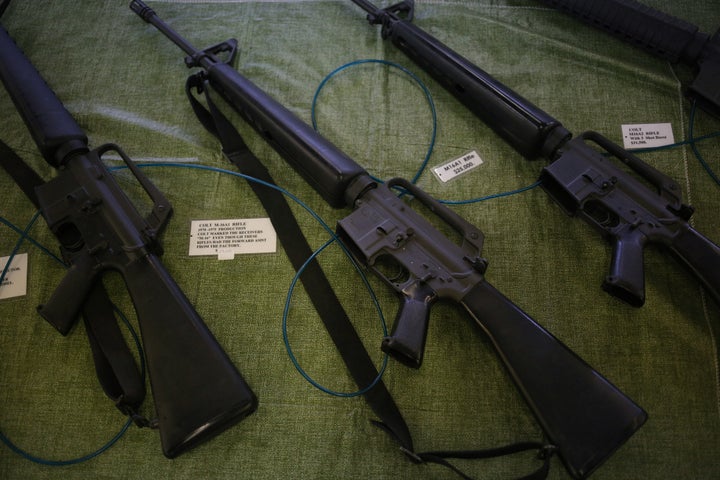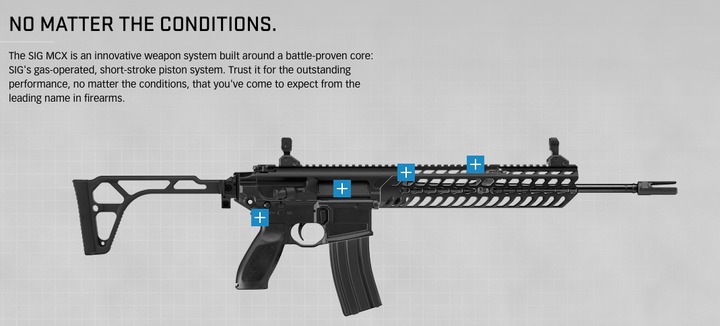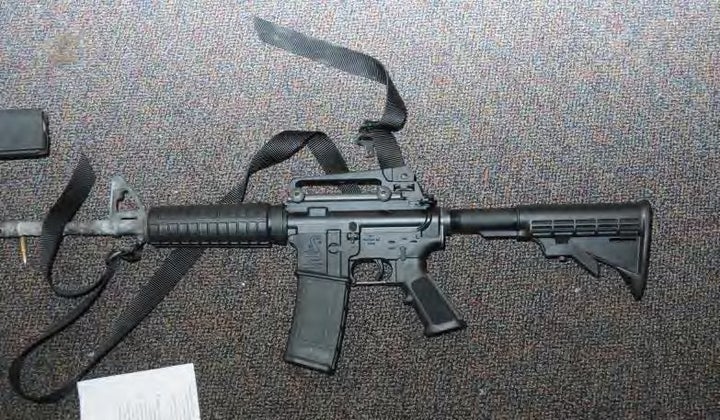As officials continue to investigate 19-year-old Nikolas Cruz, who is accused of opening fire on his former high school Wednesday afternoon, killing at least 17 people and injuring more than a dozen others, familiar details are already emerging about the weapon police believe was used in the massacre.
Police suspect Cruz was armed with at least one AR-15-style rifle and “countless magazines” in the deadly shooting at Marjory Stoneman Douglas High School in Parkland, Florida.
This adds to a disturbing trend. In many of the most deadly mass shootings in the last several years, including the Las Vegas massacre on Oct. 1 and the shooting at a Texas church on Nov. 5, the lone gunmen were armed with assault-style rifles like the one reportedly used at the Florida school.
There’s plenty of debate over what constitutes a mass shooting — as well as what drives those who commit them. But it’s increasingly clear that individuals who want to inflict mass casualties are taking advantage of the widespread availability of weapons of war.
These weapons are meant for use on the battlefield.
Renowned firearms engineer Eugene Stoner developed the first AR-15, or ArmaLite Rifle (hence the “AR”), in the late 1950s, using advances in technology and materials to revolutionize battlefield weaponry. Stoner’s rifle was marketed to national militaries interested in a lightweight firearm with precision accuracy and high lethality at long range. Colt Manufacturing Co. eventually purchased ArmaLite and convinced the U.S. military to replace the M-14 with its M-16, which employed many of the advances in the AR-15.

Many modern AR-style rifles are modeled off of these rifles and their successors, which have been the standard issue for the U.S. military since the Vietnam War. But there is one key difference: Battle-ready assault rifles have a selector switch that allows automatic fire (a continuous spray of bullets with a single pull of the trigger), or semi-automatic (one shot with each trigger pull). Civilian versions are semi-automatic only.
The AR-15′s influence is apparent on the .223 SIG Sauer MCX rifle reportedly used in the 2016 Pulse nighclub massacre in Orlando, according to Mother Jones.

Here’s how one reviewer described the SIG Sauer MCX:
SIG SAUER developed the MCX rifle for America’s special forces. Their goal: a firearm that’s as quiet as an MP5, as deadly as an AK-47, and more modular than anything ever designed.
The manufacturer touts the same qualities, saying the rifle is designed to be “silenced, light and short.”
These rifles are designed to kill as efficiently as possible.
These weapons are designed to fire off bullets very, very quickly. Some manufacturers boast that an experienced shooter could fire as many as 45 rounds in one minute. Magazines containing fresh ammunition can be swapped out in a matter of seconds.
The specifications of assault-style rifles vary depending on ammunition, but many tests put the muzzle velocity of a standard round from an AR-15 at 3,200 feet per second, making it accurate up to 500 yards ― more than a quarter-mile.
This makes rounds from an AR-15 or other assault-style weapons far more devastating than those fired from small-caliber handguns.
Here’s a video of a 5.56mm caliber round ― the kind used in many assault-style rifles ― being fired into ballistic gel meant to mimic human flesh. You can see how a single shot inflicts massive trauma, regardless of where it hits the target.
And that’s just one round. A standard AR-15 magazine holds 30 rounds. But in most states, the rifles can be legally outfitted with high-capacity magazines that can hold 60 or even 100 rounds. A gunman in Texas recently managed to fire off 212 rounds from an AR-15 during a standoff with police, though it’s unclear if he used high-capacity magazines. Six people were shot during this exchange, none fatally. If the shooter had chosen a more densely populated target, the outcome could have been much different.
AR-15 and similar weapons also are highly customizable, allowing for the addition of aftermarket sights, grips, suppressors and other accessories that make them more effective and easier to wield in combat situations.
Assault-style rifles are relatively cheap and easy to buy.
The average price of an assault-style rifle fluctuates somewhat with supply and demand. Online distributors currently offer versions for under $200, though the average price appears to be around $1,000. A SIG Sauer MCX like that used by the Orlando gunman retails for about $1,700.
In most states, anyone legally allowed to possess a handgun can also purchase an AR-15 or other assault-style rifle, with no further requirements. In Florida, for example, there is no waiting period for would-be buyers of rifles or other long guns.
Not even people on the terrorist watch list are barred from purchasing assault-style rifles. An attempt to close that loophole was voted down by Senate Republicans in 2015, and was blocked again shortly after the Orlando shooting the folllowing year.
These guns are already everywhere.
There are estimated to be millions of assault-style rifles already in civilian hands, according to recent manufacturer reports, with dozens of companies offering versions. Most of these weapons will never be used in crimes. But the threat is nonetheless present.
A suspect arrested in 2016 in Los Angeles had three of AR-15 rifles in his car, along with bags of ammo and explosive materials. He reportedly told police he was on his way to the city’s gay pride parade.
And it’s not just a matter of AR-15s and their higher-tech variants. Hundreds of thousands of new assault-style rifles flood the market each year. This includes high-powered weaponry like the AK-style rifles used in 2015 by the Planned Parenthood shooter in Colorado Springs, or the gunman who attacked a military recruitment center in Chattanooga, Tennessee.
Some states ban assault weapons, but manufacturers have found ways around the restrictions.
A number of states, including California, Connecticut, Massachusetts, Maryland, New Jersey and New York, have laws limiting or banning the sale of assault weapons. California, for example, has banned AR-15s and other rifles with detachable magazines, which allow shooters to quickly reload. However a recent feature called a “bullet button” allows magazines to be quickly replaced, while still technically remaining fixed, rendering this law largely ineffective. State lawmakers attempted to close this loophole by introducing legislation prohibiting future sales of rifles with bullet buttons, but gun owners have found ways around the ban.
Gun manufacturers have also managed to easily circumvent other state laws by making small modifications to the weapons, such as replacing the grip or other components.
Federal attempts at banning assault weapons have been largely unsuccessful.
In 1994, then-President Bill Clinton signed a federal ban on the manufacture, sale and possession of assault weapons and large-capacity magazines. The law specifically banned certain semi-automatic weapons, including the AR-15, as well as rifles that could accept detachable magazines. That ban lapsed in 2004, when Congress did not reauthorize it.
There’s been debate about how well the ban actually worked. It didn’t apply to guns manufactured prior to 1994. According to NBC News, more than 1 million assault-style rifles and 25 million guns with high-capacity magazines were grandfathered in. A 2004 study by the University of Pennsylvania found that while the ban did result in a measurable reduction in crimes involving assault weapons, crimes involving non-banned guns remained steady or increased.
“We cannot clearly credit the ban with any of the nation’s recent drop in gun violence,” concluded the study. “There has been no discernible reduction in the lethality and injuriousness of gun violence, based on indicators like the percentage of gun crimes resulting in death or the share of gunfire incidents resulting in injury.”
Pro-gun activists say this shows a new assault weapons ban wouldn’t affect gun violence. But if the ban hadn’t expired, it’s difficult to imagine these guns proliferating to the point of becoming the weapon of choice of mass shooters.
After the 2012 Sandy Hook Elementary School massacre in Connecticut, some members of Congress sought to renew the assault weapon ban. It passed the Senate Judiciary Committee in 2013, but was excluded from a vote by the full Senate due to Republican opposition. An attempt to re-attach the measure by Sen. Dianne Feinstein (D-Calif.), one of the ban’s most ardent supporters, was voted down 40 to 60.
House Democrats again pushed for renewal in late 2015, following the mass shooting in San Bernardino, California, and Feinstein reintroduced it in 2017 following the Las Vegas and Texas shootings. There’s been no action on it since.
An attempt to ban bump stocks, a device used by the Las Vegas shooter that effectively turns semi-automatic rifles into automatic ones, also failed to gain traction in Congress. (Massachusetts, however, became the first state to ban the add-on stocks earlier this month.)

Every time a gunman carries out a massacre with an assault-style rifle, sales go up.
Gun sales, particularly those of assault weapons, tend to spike after each mass shooting, fueled in part by fears that lawmakers will crack down. Already immensely popular, AR-15s and similar rifles flew off the shelves after Sandy Hook. Gun shop owners saw a similar spike after San Bernardino.
This trend is so pronounced that gun industry executives have admitted mass shootings are good for business.
Families of gun violence victims are fighting back against this profit windfall. The parents of nine Sandy Hook victims and one person who survived the massacre are suing Remington, the manufacturer of the rifle used in that shooting. The suit accuses Remington of negligence in selling a military-grade weapon for civilian use, arguing that the guns were purposefully marketed to young men as personal weapons of war.
“Remington took a weapon that was made to the specs of the U.S. military for the purpose of killing enemy soldiers in combat ― and that weapon in the military is cared for with tremendous amount of diligence, in terms of training, storage, who gets the weapon, and who can use it,” the families’ attorney, Joshua Koskoff, told CNN in February of 2016. “They took that same weapon and started peddling it to the civilian market for the purposes of making a lot of money.”
Handguns are common in single-victim gun violence, but military-style rifles are becoming the weapon of choice for mass shooters.
Tens of thousands of people die in gun violence every year, and the overwhelming majority involve handguns, not assault-style rifles or other long guns. At least 64 percent of the gun-related homicides in 2016 were committed with pistols, according to FBI data.
When shooters do turn to heavy weaponry, however, the results can be catastrophic.
Weapons of war have been used in some of the deadliest shootings over the last several years. In addition to Las Vegas, AR-15 style rifles were used during mass shootings in California, Connecticut, Florida, Oregon, Texas and Colorado.
The gun industry is trying to convince you these weapons are just for fun.
Gun advocates insist assault-style rifles are ideal for hunting and target shooting. A fact sheet published by the National Shooting Sports Foundation in 2013 condemned the “assault weapon” label, claiming the term was “conjured up by anti-gun legislators to scare voters into thinking these firearms are something out of a horror movie.” The group has repeatedly argued that the guns are useful for marksmanship competitions and hunting large game. The NRA champions the AR-15 as ”America’s rifle.”
The industry has coined the term ”modern sporting rifles″ to describe assault weapons, and the term is used by major gun retailers like Cabela’s, and manufacturers such as Smith & Wesson and Remington.
That message may resonate with gun enthusiasts. The weapons are versatile and efficient, and if you like the idea of shooting things for sport, the appeal is obvious. Assault-style weapons look cool. Shooting one might even make you feel like a badass.
But the very same traits that have made them the preferred weapon for military personnel and sport shooters are what make them a natural choice for those who want to inflict senseless violence with maximum casualties.
It now seems the toll of mass killers is limited only by their choice of weapon, their training and their target. The political response to that terrifying reality has been to hope that people will choose not to kill. That plan clearly isn’t working.
A version of this article initially ran in 2016.